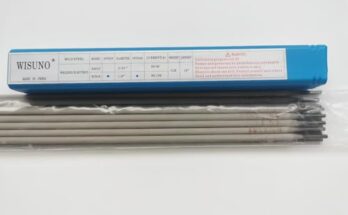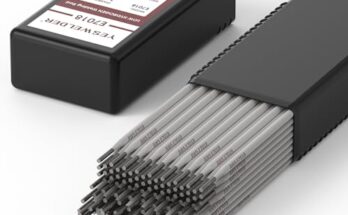Need to tackle a tough welding job? Let’s dive into the world of 9018 welding rod, a versatile and reliable option for many applications. This guide will cover its properties, uses, and everything you need to know to use it effectively.
Let’s start with the basics. What exactly is 9018 welding
rod? It’s a type of low-hydrogen electrode, meaning it contains minimal moisture which is crucial for preventing hydrogen embrittlement in the weld. This is a serious issue as hydrogen trapped in the weld metal can make it brittle and prone to cracking.
The Chemical Composition of 9018 Welding Rods
The exact chemical makeup can vary slightly between manufacturers, but 9018 rods generally contain a mix of iron, carbon, manganese, silicon, and other alloying elements. These elements work together to give the weld its strength, toughness, and weldability. Think of it like a recipe – each ingredient plays a crucial role in the final product. For instance, manganese contributes to strength and hardness, while silicon improves fluidity, ensuring a smooth weld. The low hydrogen content is a key differentiator, separating 9018 from other welding rods. This is achieved through careful manufacturing processes and packaging that minimize moisture absorption.
Mechanical Properties and Weld Characteristics
9018 welding rods produce welds with excellent mechanical properties. This means they are strong, tough, and resistant to cracking. They’re known for their high tensile strength, good impact resistance, and excellent ductility (ability to deform without breaking). These properties make them suitable for a wide array of applications demanding high strength. The weld’s appearance is typically smooth and consistent, reducing the need for extensive post-weld finishing. This is critical for efficiency, especially in large-scale projects. The tensile strength, typically exceeding 70,000 psi, is just one testament to its superior qualities.
Applications of 9018 Welding Rod
9018 welding rods are incredibly versatile. Their excellent properties make them a popular choice across several industries. Let’s explore some key applications.
Welding Mild Steel and Low Carbon Steel
9018 is the workhorse for welding various grades of mild steel and low carbon steels. This is due to its exceptional compatibility with these materials and its ability to produce strong, reliable welds. I’ve personally used 9018 extensively on structural steel work, where reliability is paramount. The consistency of the weld bead produced by 9018 is noteworthy, resulting in a high-quality finish that requires minimal clean-up.
Applications in Construction and Fabrication
In construction, 9018 finds extensive use in welding structural steel components, pipework, and various other metal parts. Its strength and durability make it ideal for applications that must withstand significant stress and strain. Fabrication shops also rely on 9018 for producing sturdy and reliable metal structures for various industries. Think about the framework of a building, the support beams in a bridge, or the intricate metalwork of a customized car – all are potential applications for 9018.
Comparing 9018 to Other Welding Rods
To truly appreciate 9018, it’s useful to compare it to other commonly used welding rods. This highlights its unique strengths and characteristics.
9018 vs. 6010 Welding Rods
While both are used for welding steel, 9018 is a general-purpose rod, suitable for various positions (flat, horizontal, vertical, and overhead), whereas 6010 is specifically designed for welding in the downhand position. 6010 welds are known for their deep penetration, but lack the versatility and consistent quality of 9018 in different welding positions.
9018 vs. 7018 Welding Rods
7018 is another low-hydrogen rod, known for its superior strength and toughness. However, 9018 is a more economical choice for many applications, providing a good balance of strength, weldability, and cost. The selection often comes down to the specific requirements of the project and the desired level of strength and toughness. For instance, a high-stress application might call for 7018, while less demanding jobs may find 9018 perfectly adequate.
Factors Affecting Weld Quality with 9018
Achieving a strong and reliable weld with 9018, like with any welding rod, depends on several crucial factors. Neglecting these details can lead to subpar welds or even catastrophic failures.
Proper Electrode Storage and Handling
Keeping 9018 rods dry is paramount. Moisture absorption drastically affects the weld quality. Storing the electrodes in a sealed container with a desiccant to absorb moisture is essential. Improper handling can introduce moisture, leading to porosity (small holes) and hydrogen embrittlement in the weld.
Importance of Proper Welding Technique
The correct welding technique, including consistent arc length, travel speed, and current settings, plays a crucial role in producing high-quality welds with 9018. Inadequate technique can result in a variety of issues, including undercutting (a groove at the edge of the weld), lack of fusion (incomplete weld penetration), and excessive spatter. The welder’s skill and experience are critical factors in obtaining the best possible results.
Safety Precautions When Using 9018 Welding Rods
Welding inherently involves risks, and safety must always be the top priority. Proper safety procedures are non-negotiable.
Personal Protective Equipment (PPE)
Always wear appropriate PPE, including a welding helmet with a suitable shade lens, welding gloves, and protective clothing. The intense heat and bright light generated during welding can cause serious eye and skin damage. Ignoring safety equipment is a recipe for disaster.
Ventilation and Respiratory Protection
Welding produces fumes that can be hazardous to your health. Ensure adequate ventilation in the workspace, and consider using a respirator if necessary. The type of respirator will depend on the specific application and potential hazards. Long-term exposure to welding fumes can cause various health issues, making respiratory protection a crucial aspect of welding safety.
Troubleshooting Common Problems with 9018 Welding
Even experienced welders encounter occasional problems. Knowing how to troubleshoot common issues is essential for consistent quality.
Porosity in the Weld
Porosity, small holes in the weld, often indicates moisture contamination in the electrode or improper welding technique. Check for moisture absorption in the electrode and review the welding parameters (current, voltage, travel speed).
Lack of Fusion
Lack of fusion, where the weld metal doesn’t properly join the base metal, often arises from insufficient heat input or improper welding technique. Ensure proper cleaning of the base metal, adequate preheating (if required), and consistent welding techniques.
Advanced Techniques and Applications
Once you’re comfortable with basic 9018 welding, you can explore more advanced applications and techniques.
Welding in Different Positions
9018’s versatility allows welding in various positions (flat, horizontal, vertical, and overhead), requiring adjustments in technique and parameters to compensate for gravity’s effects on the molten weld pool.
Multi-pass Welding
For thicker materials, multi-pass welding might be necessary. Each pass builds upon the previous one, requiring careful control of heat input to prevent overheating or distortion.
The Cost-Effectiveness of 9018 Welding Rods
9018 offers a balance between performance and cost, making it an economically viable option.
Comparing Prices with Other Welding Rods
Compared to other specialty welding rods, 9018 is generally more affordable, offering excellent value for its mechanical properties and versatility. This makes it suitable for a wide range of projects where cost-efficiency is a factor.
Long-Term Savings Through Reliability
The reliability of 9018 minimizes rework, reducing overall project costs. A reliable weld means less time and effort spent on correcting defects or replacing faulty components, ultimately reducing costs.
Frequently Asked Questions
What is 9018 welding rod best for?
9018 welding rod excels in general-purpose welding applications, particularly for mild steel and low-carbon steel. Its versatility makes it suitable for various tasks in construction, fabrication, and manufacturing. Learn more about its applications in different industries.
What are the limitations of 9018 welding rod?
While versatile, 9018 isn’t ideal for every scenario. Its strength and toughness might not be sufficient for high-stress applications where a stronger electrode, such as 7018, might be preferred. It’s also not suited for welding dissimilar metals, each requiring specific electrode types.
How do I store 9018 welding rods properly?
Proper storage is crucial for maintaining the low-hydrogen properties of 9018. Store them in a dry, airtight container with a desiccant to prevent moisture absorption. Exposure to moisture can drastically impact weld quality and strength.
What are the safety precautions I should take when using 9018 welding rods?
Always wear appropriate Personal Protective Equipment (PPE), including a welding helmet, gloves, and protective clothing. Ensure adequate ventilation or use a respirator to prevent inhaling harmful fumes. Learn more about welding safety practices.
What are the common problems encountered when using 9018 welding rods and how to solve them?
Common issues include porosity (small holes) and lack of fusion. Porosity often results from moisture contamination or improper technique. Lack of fusion indicates insufficient heat or poor base metal preparation. Addressing these issues requires careful attention to storage, technique, and base metal cleaning.
How does 9018 compare to other low-hydrogen electrodes?
Several low-hydrogen electrodes exist, each with subtle variations in properties. 7018, for instance, offers superior strength but at a higher cost. 9018 provides a balance between strength, weldability, and cost-effectiveness, making it a popular choice for many applications.
Can I use 9018 welding rods on stainless steel?
No, 9018 is not suitable for stainless steel welding. Stainless steel requires specialized electrodes designed for its unique properties to prevent weld cracking and ensure proper corrosion resistance. Using 9018 on stainless steel would likely result in a poor-quality and potentially weak weld.
Final Thoughts
9018 welding rod offers excellent versatility and performance for a wide array of mild steel welding applications. Its cost-effectiveness and ease of use make it a popular choice for both professionals and hobbyists. Understanding its properties, applications, and potential issues allows for consistent high-quality welds, making it a crucial tool in various industries. Remember to always prioritize safety and utilize appropriate PPE when working with 9018 or any welding rod. Whether you’re a seasoned welder or just starting your journey, mastering the use of 9018 can significantly enhance your welding skills and project outcomes. Now go out there and make some strong welds!


